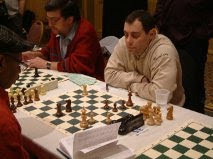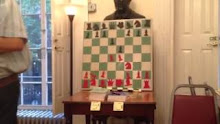1.d4 Nf6 2.c4 g6 3.Nc3 Bg7 4.e4 d6 5.f3 O-O 6.Bg5
In a previous encounter, play had proceeded 6.Be3 b6 7.Bd3 Bb7 8.Nge2 c5 9.d5 e6 10.Bg5 exd5 11.exd5 Nbd7 12.b3 a6 13.a4 Qc7 14.O-O h6 15.Bh4 Ne5?! (better is 15...Rae8) 16.Bc2 Nh7 17.Qd2 f5?! 18.Nf4 Qf7 19.Ne6 Rfe8 20.Nxg7?! Qxg7 21.Bg3 Nf7 22.Rae1 Nf8 +/= but 0-1 in 70 moves, Pete Radomskyj - Jim West, Elmwood Park Futurity 1990.
6...c5 7.d5 e6 8.Bd3
More often seen is 8.Qd2 exd5 9.cxd5 with a position from the Benoni, usually reached by 1.d4 Nf6 2.c4 c5 3.d5 e6 4.Nc3 exd5 5.cxd5 d6 6.e4 g6 7.f3 Bg7 8.Bg5 O-O 9.Qd2.
8...exd5 9.cxd5
Instead Petrosian-Suetin, USSR 1959 continued 9.exd5 Nbd7 10.Nge2 Ne5 11.O-O h6 12.Bh4 Re8 = (ECO).
9...a6 10.a4 Nbd7 11.Nge2 Qc7 12.a5 Ne5 13.O-O Bd7 14.Be3 Rfb8 15.Kh1 b5 16.axb6 Rxb6 =/+
White has drifted aimlessly for the last few moves, while Black has been preparing the thematic ...b5 break. Now Black has a Benko Gambit formation without even being a pawn down.
17.Ra2 Qb7 18.Bc1 Nxd3 19.Qxd3 Ne8 20.f4 Rb3 21.Qc2
Black's threat was 21...Bb5.
21...Rb4 22.f5
With a bad queenside position, White looks to a mating attack as his only chance.
22...Bb5
Finally the drawback of 8.Bd3 can be seen. The exchange of knight for bishop on move 18 has left White with light-square weaknesses which would not be remedied fully after 23.Nxb5 Qxb5 followed by 24...Qc4. For example, 24.Re1 Qc4 25.Qxc4 Rxc4 26.Ng3 Rc2, and White's pieces are badly placed.
23.Rf3 Bc4 24.Ra1 Rb8 25.Nf4 Be5 26.Qf2 Rxb2!
Just when White's kingside threats were beginning to grow to menacing proportions, this exchange sacrifice on the other side of the board diverts White's attention from the enemy king.
27.Bxb2 Qxb2 28.Qxb2 Rxb2
Although Black has only one pawn for the exchange, it's an outside passed pawn. That, plus Black's protected passed c-pawn and White's backward e-pawn, gives Black excellent chances. Having the bishop pair doesn't hurt, either. But Black will soon exchange both bishops for White's knights in order to win a second pawn.
29.Rc1 Rb3 30.fxg6 hxg6 31.Nce2 Rb4 32.Ng3 Nf6 33.h3 Kg7 34.Re1 a5 35.Nd3 Bxd3 36.Rxd3 Bxg3 37.Rxg3 Nxe4 -/+
Black's knight and two passed pawns clearly outmatch White's extra rook.
38.Ra3 a4 39.Rea1 Kf6 40.Rf3+
White also loses after 40.Rxa4 Rxa4 41.Rxa4 Ke5 42.Ra7 f6 43.Rg7 g5 and 44...Kxd5.
40...Ke5! 41.Rxf7 Kxd5 42.Rg7
There is no time for 42.h4 c4 43.Rg7 c3 44.Rc1 a3 45.Rxg6 a2.
42...g5 43.Rg6 c4 44.Rd1+ Kc5 45.Kg1 a3 46.Ra1 c3 47.Rg8 Kd4 48.Rc8 Rc4 49.Rd1+ Nd2 50.Ra8 Kd3 51.Rxa3 d5 52.Rc1 d4 53.g3 Rb4 54.h4 gxh4 55.gxh4 Rb1!
Black's piece play on the b-file continues to serve him well.
56.Ra1
No better is 56.Rxb1 Nxb1 57.Rb3 (57.Ra1 c2) Kd2! 58.Rxb1 c2 59.Rf1 c1=Q 60.Rxc1 Kxc1 61.h5 d3, and Black wins because the d-pawn queens with check.
56...Rxa1 57.Rxa1 c2 58.Rc1
On 58.h5, Black wins at once with 58...Nb1.
58...Nf3+ 59.Kf2 Nxh4 60.Kg3 Kd2 61.Rxc2+ Kxc2 62.Kxh4 and White resigns.
{This article originally appeared in Atlantic Chess News in 1992}




























